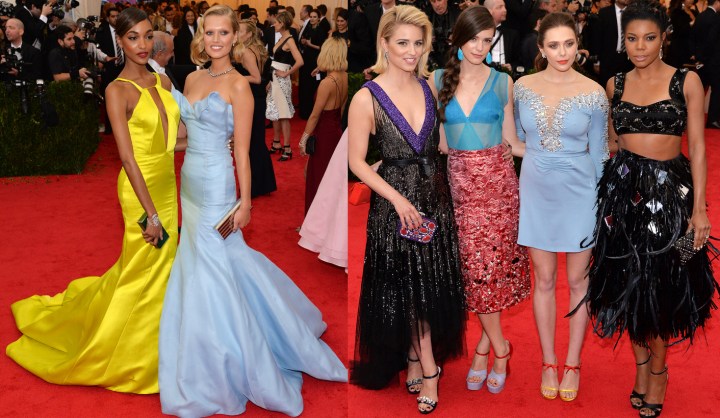Maverick Life
Chronicles of Chic: Met Ball 2014 – tasteless, pompous, important, brilliant

On Monday night, amidst the ball gowns, tails, colourful decorations, long gloves and Dionysian festivities, the Metropolitan Museum of Art honoured 20th century couturier Charles James. The event served to unveil the renovated galleries and the newly christened Anna Wintour Costume Centre; it celebrated Vogue editor-in-chief’s incredible knack and dedication to fashion and shone a bright light on an industry often criticised for being shallow and frivolous. By EMILIE GAMBADE.
The annual Costume Institute spring exhibition this year is a tribute to British-born American-based fashion designer Charles James. Running from 8 May to 10 August, the museum’s galleries provide the perfect case for 70 outfits – more architectural carvings in cloth than garments – that represent the designer’s extensive career and imprint on fashion.
James, who started as a milliner, was a rigorous romanticist, a visionary, a Buddy Holly of fashion; born in 1906, he used his incredible understanding of proportions, volumes and anatomy to create gowns that underlined the body with the precision of a sharp pencil. In 1928, he left millinery to create dresses, introducing drapes, folds, wraps and straight forms. His designs, dubbed ‘the Taxi dress’, ‘the jersey Lobster dress’, ‘the ‘Tree ball gown’ that traced the silhouette down to the upper calves and opened swiftly into a corolla of nylon tulle, or the eiderdown jacket, paved the way for international couture (Christian Dior’s introduction of his New Look was inspired by James’ work).
“He was an artist who happened to be working with fashion as his medium,” said curator of the exhibition Harold Koda.
James constructed garments to change the form of the human body; he used fashion to enhance and metamorphose the silhouette the way architects reshape urban landscapes. The Met Ball 2014 helps understanding the career of a designer who dreamed up a mould that made international couture possible; the exhibition also provides an opportunity to appreciate the making of the garments, thanks to a robotic arm floating around the pieces, presented on a pedestal like weightless sculptures, tracking down specific features and translating them into detailed explanations.

Photo: British editor in chief of the US Vogue, Anna Wintour arrives for the 2014 Anna Wintour Costume Center Gala held at the New York Metropolitan Museum of Art in New York, New York, USA, 05 May 2014. EPA/JUSTIN LANE
That Anna Wintour, the legendary editor of Vogue, would spend her energy and long list of connections to organise a memorable ball every year, to help launch such exhibitions, and have invitees splash out $25,000 on a ticket and bravely stick to her strict dress code, is nothing short of remarkable. Wintour, who has been the editor-in-chief of Vogue since 1988, is known for strongly supporting a global industry that was valued at, according to Fashion United, “US$1.7 trillion in 2012 and [employed] approximately 75 million people”. Beyond her influential role, she is involved in initiatives that go from the creation of the CFDA/Vogue Fashion Fund (the fund gives mentorship, exposure and financial support to upcoming designers) to Fashion Night’s Out, “a one-night festival of style and commerce, from New York to cities across the globe”.

Photo: US socialite Kim Kardashian (L) and US singer Kanye West (R) arrive for the 2014 Anna Wintour Costume Center Gala held at the New York Metropolitan Museum of Art in New York, New York, USA, 05 May 2014. EPA/JUSTIN LANE
In fact, the Met Ball is part of a wide swat of activities that support the fashion industry; the exhibitions it helps to fund aim at educating an audience on the beauty of a garment, the history of its making, the ubiquity of a trend or the impact of one designer; it brings fashion back in context (how it mirrors – mainly Western – societies) and lifts it to art. It serves as a case for treasures of couture and craftsmanship, highlighting an industry that, beyond a crust of bling and haughtiness, is filled with talent, unique skills and revolutionary technology. It underlines the (huge) difference between fast fashion (hit-the-shelves-bought-and-thrown-away garments) to couture or prêt-a-porter made often locally with care and attention. For all these reasons, the Gala, which raised $10 million in 2011, is critical.
Of course, the irony is that the very event that is supposed to launch the tribute to Charles James, who died from pneumonia “alone and penniless” at the Chelsea Hotel in 1978, and his extraordinary work, is a Pandora’s box for fashion elitism: the handpicked list of invitees includes Hollywood celebrities (to name but few, Kim and Kanye, Rihanna, Cara Delevingne, up and coming Shailene Woodley and irresistible fashion darling, Lupita Nyong’o – who graced the red carpet in a green fishnet Prada dress that had everybody boo in horror), well established designers who have long forgotten the bitter taste of sleepless nights behind a sewing machine, and anyone with a cheque book big enough to pop the $25,000 for an entry ticket (not that it will automatically open the Sesame door: Madonna was denied access to the Met Ball after she posted a picture of the bare-chest outfit she would wear on the night). The vast majority of the guests present on the night would have rented their outfit or have it lent by a brand in hope for a much-wanted exposure. It is, certainly, a bonfire of fashion vanities.

Photo: Madona’s ‘censored’ ‘outfit’. Photo: Instagram.
Yet ultimately, what seems like a privileged, look-at-me-I’m-famous fashion event is also the backbone for deeper, more interesting conversations around fashion than the simple sartorial analysis of who wore what on the night. Despite the faux pas (and this year seemed to be a paragon of tasteless pompousness), it still has the ability to merge fashion heritage with pop culture, drag audiences to exhibitions that focus on fashion as an art form, with its litany of good and bad intentions, and bring its usual exclusiveness back to the masses. It also shows the long road to fashion creation, far from the usual flummery and frivolity.
As Miranda Priestly in The Devil Wears Prada said, “… What you don’t know is that that sweater is not just blue, it’s not turquoise, it’s not lapis, it’s actually cerulean. You’re also blithely unaware of the fact that in 2002, Oscar de la Renta did a collection of cerulean gowns. And then I think it was Yves St. Laurent, wasn’t it, who showed cerulean military jackets? And then cerulean quickly showed up in the collections of eight different designers. Then it filtered down through the department stores and then trickled on down into some tragic Casual Corner where you, no doubt, fished it out of some clearance bin. However, that blue represents millions of dollars and countless jobs and so it’s sort of comical to me how you think that you’ve made a choice that exempts you from the fashion industry when, in fact, you’re wearing the sweater that was selected for you by the people in this room. From a pile of stuff.” DM
Main photo: Main photo: (LEFT) German model Toni Garrn (R) and British model Jourdan Dunn. (RIGHT) (L-R) US actress Dianna Agron, British actress Stacy Martin, US actress Elizabeth Olsen and US actress Gabrielle Union arrive for the 2014 Anna Wintour Costume Center Gala held at the New York Metropolitan Museum of Art in New York, New York, USA, 05 May 2014. The Costume Institute’s new Anna Wintour Costume Center opens on 08 May with the exhibition ‘Charles James: Beyond Fashion.’ EPA/JUSTIN LANE















 Become an Insider
Become an Insider